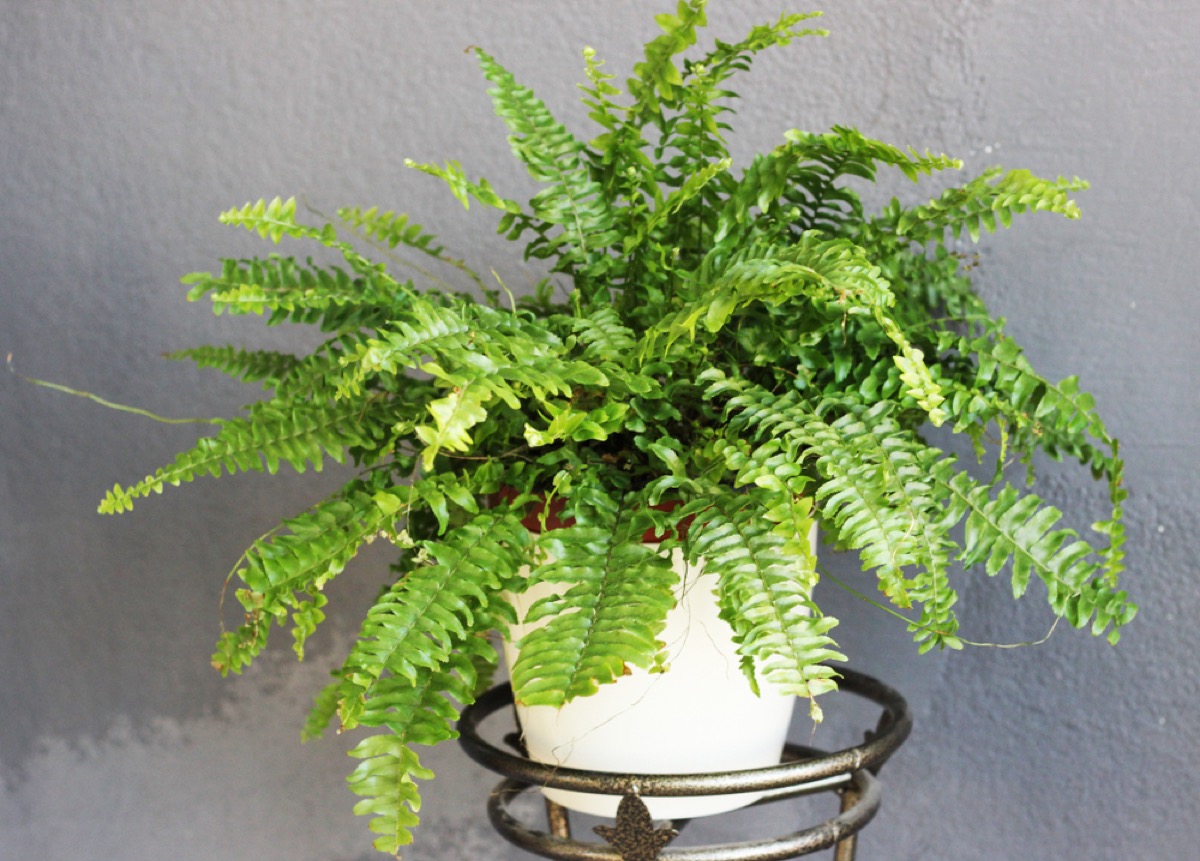The Jester Crown Fern, with its distinctive fronds and colorful appearance, is a popular choice for indoor spaces and can add a touch of whimsy to any room. The Boston Fern, with its delicate, arching fronds and classic appearance, is a timeless favorite that has been popular for over a century. While both ferns have similar care requirements, there are several key differences between the two that gardeners should be aware of when choosing which to add to their plant collection. Understanding the differences between the Jester Crown Fern and Boston Fern can help gardeners select the right plant for their needs and create the best growing conditions for their chosen fern.
Jester Crown Fern Overview

The Jester Crown Fern, scientifically known as Nephrolepis exaltata, is an ancient plant native to the rainforests of Australia and New Guinea1. This bushy, sturdy fern is known for its long, arching, deep-green fronds that grow out from the base of the plant2.
Being one of the oldest plants on Earth, the Jester Crown Fern shares similarities with the Boston Fern (Nephrolepis obliterata) but distinguishes itself through its unique appearance34. This fern prefers partial light and typically grows to a height of 12-18 inches (30-46 cm) and a width of 14-20 inches (36-51 cm), making it an attractive option for indoor and outdoor gardening5.
To grow successfully, the Jester Crown Fern requires aerated soil mix containing bark, coarse perlite, and peat moss6. It thrives in medium to low, diffused light and should be provided with moist soil to ensure optimal growth7.
Boston Fern Overview

The Boston fern, also known as Nephrolepis exaltata or sword fern, is a popular fern species that grows in many tropical areas around the world. It has arching fronds that reach two to three feet tall and wide, displaying a green or bluish-green color. These ferns can thrive for years with the right care, whether grown on a porch, outdoors in dappled shade, or potted near a bright window with indirect light (Southern Living) .
Indoor care of this classic houseplant typically involves maintaining high humidity, achieved through misting and placing the plant on a tray of wet pebbles. It is important to note that if humidity levels are not met, the plant can struggle, losing its small brown leaflets in the process (Better Homes & Gardens) . Outdoors, Boston ferns thrive in swampy, humid, and forested areas, making them a great addition to partial-shade gardens (The Spruce) .
Appearance and Foliage
Jester Crown Fern Features
The Jester’s Crown Fern is known for its bushy and sturdy growth, with long leaves that create a lush rainforest ambiance. This fern has deep-green fronds that arch out from the base of the plant, giving it a unique and attractive appearance in any indoor or outdoor settingJester’s Crown Fern | Plant Addicts.
Typically growing to a height of 12-18 inches and a width of 14-20 inches, Jester’s Crown Fern thrives in partial light conditionsMy Plantin. This type of fern prefers an aerated soil mix containing bark, coarse perlite, and peat moss to ensure optimal growth and foliage qualityMy Plantin.
Boston Fern Features
Boston Fern, on the other hand, is characterized by its gracefully arching fronds that cascade down from the center of the plantBetter Homes & Gardens. When grown in the right conditions, Boston Fern can produce dense foliage with a bright, vibrant green hue, creating a visually stunning effect in any space, indoors or outdoorsBetter Homes & Gardens.
For ideal growth, Boston Ferns require bright, indirect light and a sheltered location to prevent burning of the frondsBetter Homes & Gardens. These ferns can grow quite large, reaching heights of up to 6 feet and widths of 3-6 feet, depending on the environmentGarden Lovers Club. They prefer well-drained soil that stays evenly moist to maintain their lush appearance and overall healthGarden Lovers Club.
Growing Conditions
Both Jester’s Crown Fern and Boston Fern thrive in specific growing conditions. Understanding these requirements can help encourage healthy growth and maintain the plants’ beauty.
Soil Requirements
For Jester’s Crown Fern, an aerated soil mix containing bark, coarse perlite, and peat moss is optimal for growth. For the Boston Fern, ensure you have a well-draining, moist, and rich soil mix.
Watering
Consistently moist soil without waterlogging is crucial for both Jester’s Crown Fern and Boston Fern. It is vital to avoid letting the soil dry out, as this can harm the planta>.
Sunlight Exposure
Jester’s Crown Fern prefers partial light, while Boston Ferns require bright, indirect light when grown indoors and must be sheltered from direct sun outdoors to prevent burning.
Temperature and Humidity
Both fern types appreciate a humid environment, with Boston Ferns thriving in humidity levels above 80%. Boston Ferns prefer temperatures between 65 and 75 F and struggle with extremes above 95 F and below 35 F. While Jester’s Crown Ferns may tolerate slightly different temperature ranges, maintaining a consistently warm and humid environment will benefit the overall health of both fern varieties.
Care and Maintenance
Pruning
Jester Crown Ferns and Boston Ferns both benefit from regular pruning to maintain their health and appearance. Removing dead, yellowing, or damaged fronds will encourage new growth and help prevent diseases. When pruning, use clean, sharp scissors or pruning shears and make cuts near the base of the frond.
Fertilizing
Both fern varieties require minimal fertilizing. For Jester Crown Ferns, a soil-based potting mix that is rich in peat will provide most of the necessary nutrients (Cellar Door Plants). Boston Ferns will benefit from a houseplant fertilizer applied at half strength every month from spring to early fall (Better Homes & Gardens).
Pests and Diseases
Both fern types can be affected by common pests such as aphids, mealybugs, and spider mites. Regularly inspecting your ferns for signs of pests and treating them with appropriate insecticidal soaps or solutions can help keep infestations at bay. For diseases, maintaining proper watering practices and providing adequate air circulation around the plants can help prevent problems like fungal infections and root rot.
Keeping the humidity level high, similar to their natural habitat, is crucial for optimal growth and to deter pests. Inadequate humidity can cause the fronds to brown and become prone to pests. Both Jester Crown and Boston Ferns benefit from being placed near a tray of water, which will help maintain the humidity around the plants (Gardening Know How).
Uses and Benefits
Both Jester Crown Ferns and Boston Ferns are popular choices for indoor plants due to their unique beauty and air-purifying capabilities. They thrive in moist, high humidity environments, which makes them effective at removing moisture from the air and even some toxins (A-Z Animals). These ferns provide a lush, green touch to any space, boosting the visual appeal without demanding excessive care.
The Jester Crown Fern is a low-maintenance plant that can live for years with proper care, making it an excellent choice for beginners and experienced plant enthusiasts alike (Cellar Door Plants). On the other hand, Boston Ferns, though slower to grow and mature, are also appreciated for their easy care, with long arching stems of spring-green foliage that look stunning when allowed to cascade over the edges of a hanging container (Better Homes & Gardens).
In summary, both Jester Crown Ferns and Boston Ferns offer several benefits, including air purification, humidity control, and aesthetic appeal. Their low-maintenance nature and adaptability to indoor environments make them an excellent choice for enhancing living spaces with a touch of natural beauty.
Helpful Video

My name is Daniel Elrod, and I have been houseplant love ever since I was 17. I love how much joy they bring to any room in the home. I’ve always been amazed at how a few pots of flowing leaves can turn a drab and sterile office into an inviting place where people love to work at.































